Knee & Leg Pain
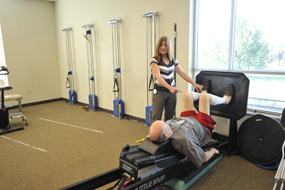 Pain is broken down into two categories: acute or chronic. If you fall down and hurt your knee or twist your knee, that is called "acute" knee pain. Chronic pain is something that occurs more gradually over time, often getting worse as weeks and months go by.
Pain is broken down into two categories: acute or chronic. If you fall down and hurt your knee or twist your knee, that is called "acute" knee pain. Chronic pain is something that occurs more gradually over time, often getting worse as weeks and months go by.
Unlike acute pain which can be linked to a specific event or time - like when you fall or twist your knee - chronic pain is more like an ache that is not linked to any event. The knee specialist will ask when and how your pain started to learn more about the potential cause of pain.
Strains & Sprains
These two terms are sometimes used together. However, technically they differ. A strain occurs when a muscle is overworked or overstretched. Sprain relates to ligaments, or tendons. For instance a strain can occur at the start up of a new exercise regime. If the body is not properly stretched, than sudden impact can tear muscles, ligaments, tendons, and soft tissues. As our body becomes accustomed to an exercise, say running, it compensates forpotential injuries by strengthening muscles and ligaments. If we start a running program after living a relatively sedentary lifestyle, our body has not had a chance to compensate yet, and we are more prone to a strain.
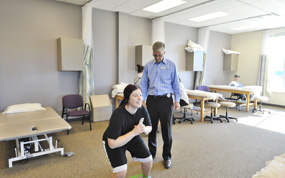 If you are about to start up an exercise program remember to STRETCH before embarking upon the new activity. That is crucial. Also try to ease into the program allowing your body to strengthen before pushing it to the limit.
If you are about to start up an exercise program remember to STRETCH before embarking upon the new activity. That is crucial. Also try to ease into the program allowing your body to strengthen before pushing it to the limit.
Sprains relate to an over-stretched or torn ligament. Usually, the sprain is tender or swelling occurs and it can look black and blue like a bruise. This is a little more serious because this indicates a torn ligament. Tears are more severe than strains or sprains. When muscles, ligaments, or tendons are torn they are actually disrupted. The torn ends grossly disrupt the continuity of their structure.
The location of the injury should clarify any confusion over whether it is a sprain or strain. Strains occur in the muscles of the neck, back, thighs and calves. Sprains are found around joints—knees, ankles, or wrists.
Ligament Problems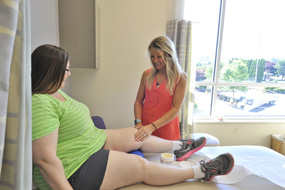
An increase in interest in sports seems to have been the catalyst for more and more ligament problems every year. In fact, there are more than 50,000 hospital admissions for ligament repair. Interestingly, women are 8 times more likely to have an ACL tear than men. Some experts theorize it may relate to high heals or anatomy. The ACL (anterior cruciate ligament) and the MCL tend to be particularly susceptible to injury during sports. The cause is generally turning quickly and twisting the knee, slowing down when running, and landing from a jump. High risk sports include soccer, skiing, basketball, and tennis.
Pain from Meniscus Tears
Meniscal tears stem from sports-related injuries or even from seemingly innocuous activities such as squatting. Athletes who play football, basketball, and tennis as well as adults over the age of 40 are especially prone to meniscus tears. The type of movement that most often causes meniscal injury is one in which the foot is firmly planted on the ground while the knee is twisted. Shoes with cleats often contribute to this type of injury by anchoring the lower leg into the ground and preventing it from moving with the knee.
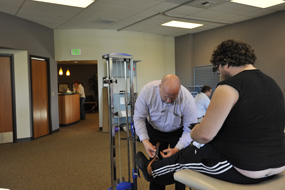 Fractures
Fractures
A bone can break for a number of reasons. A traumatic injury such as a car accident can cause a bone to break. Other causes for bones breaking can be "stress" fractures where a bone is used repetitively and because of compression, it breaks.
Dislocation
Sometimes, especially while doing something physically strenuous, we can throw a joint out of alignment with the bone. Although nothing breaks, the alignment is off. This is called dislocation.
Chondromalacia
Chondromalacia indicates a degenerative condition that results from chronic wear on the kneecap. Over time this cartilage may fray and soften. It is a degenerative condition, which occurs as the result of chronic wear of the kneecap against the femur. The articular cartilage gradually softens and then frays. In other circumstances, it can stem from one particular, traumatic incident. Symptoms for this condition could be pain at the front of the knee, especially when walking up and downhill, stiffness after prolonged sitting, and a grinding or clicking sensation as the knee is flexed and extended. This condition is more common in middle age. It happens mostly to women and can stem as early as in the teenage years.
Arthritis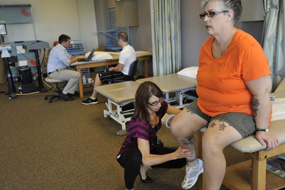
Arthritis: Osteoarthritis
This is a degenerative joint disease stemming from wear and tear on the knee usually affecting those in middle age and older. Osteoarthritis causes the cartilage to erode away. Symptoms include pain, stiffness, and swelling that at first happens once in a while but can progress to chronic pain.
Arthritis: Rheumatoid Arthritis
Unlike osteoarthrits, this type of arthritis does not erode the cartilage slowly, rather it inflames the joint (usually many joints at one time) until the joints are ruined. Rheumatoid arthritis is most common in middle aged women, but can affect people of all ages.
Arthritis: Crystaline Arthritis
Inflammation of the joints can occur when a small granual of sodium urate (related to gout) or calcium phosphorate (related to chondrocalsinosis) gets lodged in the joint. The effect is similar to getting a piece of sand trapped in your eye. It irritates the surrounding inflammation. Middle-aged men are most prone to this sort of arthritis.
Pre-Patellar Bursitis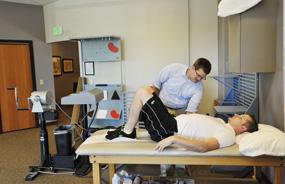
Between the tendon and the skin are small sacs called bursae which allow the skin to smoothly and painlessly slide over bones. When the bursae become inflamed, any knee movement can cause pain. In the knees, one function of the bursae is to allow the knee cap to move around freely without pain. Repetitive kneeling and/or direct impact on the knee can cause the bursae to swell and cause pain. Those in professions where the knees are often bent such as masonry, house cleaning, carpet layers, and electricians are more likely to experience post-patellar bursitis. At other times, the condition can occur when the sacs become infected. Usually for this ailment surgery is not necessary (although may be called upon in extreme cases) and treatment includes avoiding bending of the knees and relieving pressure to the knee cap.
The Four Most Common Knee Problems
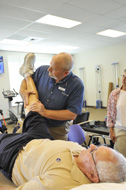 Knee cap pain - the pain usually become most noticeable when walking up stairs, going down stairs, running or sitting.
Knee cap pain - the pain usually become most noticeable when walking up stairs, going down stairs, running or sitting.
Pain from a torn meniscus - the meniscus is the cartilage that keeps the femur (the thigh bone) and the tibia (the shin bone) from hurting or grinding when they rub against each other. If the meniscus is torn, stretched or out of place, pain may occur when the joint is moved.
Pain from ligament problems - there are four ligaments in the knee: the anterior cruciate ligament, the posterior cruciate ligament, the medial collateral ligament, and the lateral collateral ligament. When the ACL is torn, it is often because the leg rotates while the foot stays planted on the ground. Often times an ACL tear is accompanied by a loud popping sound from the knee and the support of the knee gives way. A posterior cruciate injury happens when the knee is forced backwards or when it receives a hard impact. A medial collateral ligament injury most commonly occurs when the knee is hit from the outside while a lateral collateral ligament injury occurs when the knee is impacted from the inside.
Pain from tendon problems - inflamed tendons that connect the knee cap to the shin bone can cause pain.
Disclaimer:
The pictures displayed in Longview Physical & Sports Therapy are images of physicians, patients and employees who have consented to have their pictures in this website.
![]()
Website Design & Educational Content © Copyright 2023 Medingenuity, LLC MedIngenuity, LLC
Medingenuity develops content-rich educational web sites for physical therapy companies.



